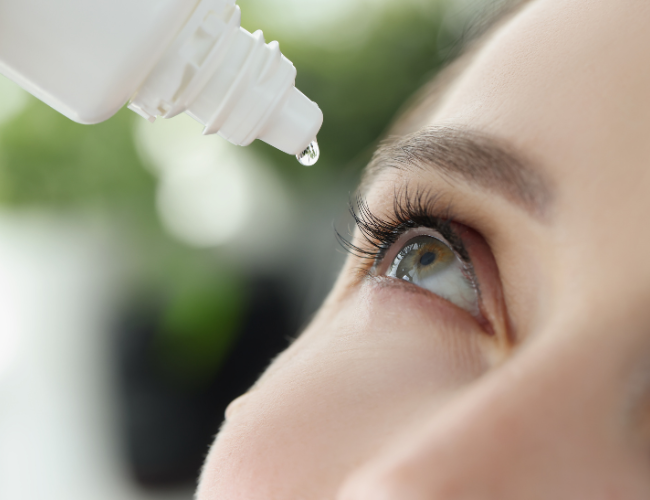The Food and Drug Administration (FDA) has issued a warning about a voluntary recall of 27 over-the-counter eye drop products due to potential contamination, posing risks of bacterial infections, vision loss, and even blindness.
This recent development has raised concerns among consumers and prompted major retailers such as Amazon, CVS, Rite Aid, and Target to remove the affected products from their shelves.
The recall, announced on November 15, comes after investigators found unsanitary conditions during the manufacturing process, prompting the FDA to take action.
Here, we delve into the details of this recall, explore the dangers associated with contaminated eye drops, and provide essential guidance for consumers affected by this issue.

What Caused the FDA Warning About Eye Drops?
Unsanitary Conditions Uncovered
The FDA’s decision to recall 27 eye drop products stems from unsanitary conditions discovered during the manufacturing process.
Kilitch Healthcare India Limited, the company responsible for producing these eye drops, was found to have operated under substandard cleanliness protocols, raising concerns about the safety and quality of the manufactured products.
As a result, the FDA deemed it necessary to issue a voluntary recall to prevent potential harm to consumers.
Impact on Major Retailers
This recall affects a wide range of popular brands that are commonly distributed through major retailers.
Brands marketed under the banners of CVS Health, Rite Aid, Target, Walmart, and others have been implicated in the recall.
Additionally, Amazon responded to the FDA warning by halting the sale of several affected eye drop products, further illustrating the widespread impact of this issue on both physical and digital retail platforms.
Recalled Products and Manufacturers
The recall encompasses all lot numbers and expiration dates for the 27 identified eye drop products.
These items are marketed under various brand names, creating a significant challenge for consumers who may have purchased them without awareness of the potential risks. The table below provides an overview of the affected brands and manufacturers.
| Brand | Manufacturer |
| CVS Health | Kilitch Healthcare India Ltd |
| Leader | Kilitch Healthcare India Ltd |
| Rugby | Kilitch Healthcare India Ltd |
| Target Up&Up | Kilitch Healthcare India Ltd |
| Velocity Pharma | Kilitch Healthcare India Ltd |
| Walmart | Kilitch Healthcare India Ltd |
Can Eye Drops Cause a Bacterial Infection?
Risks Associated with Contaminated Eye Drops
Contaminated eye drops pose a serious risk of bacterial infection, which can lead to a range of complications including redness, swelling, discharge, and even impaired vision.
When applied to the eyes, contaminated solutions introduce harmful bacteria directly into a sensitive and vulnerable area, increasing the likelihood of infection. Without prompt intervention, these infections can escalate, potentially resulting in long-term damage or vision loss.
Potential Consequences of Infection
The consequences of using contaminated eye drops extend beyond temporary discomfort.
Bacterial infections in the eyes can progress rapidly, causing severe pain, blurred vision, sensitivity to light, and in extreme cases, permanent vision impairment or blindness. Given the delicate nature of ocular health, any compromise to the sterility and safety of eye drop products poses a significant threat to consumers.
Importance of Seeking Medical Attention
If you have used any of the recalled eye drop products and experience symptoms such as unusual eye irritation, redness, discharge, or changes in vision, it is crucial to seek immediate medical attention.
While most eye infections are treatable, delays in receiving appropriate care can exacerbate the condition and heighten the risk of lasting damage.
What Are the First Signs of Eye Infection?
Recognizing Symptoms
The initial signs of an eye infection may include redness, itchiness, excessive tearing, or a feeling of grittiness within the eye.
Additionally, individuals may experience increased sensitivity to light, blurred vision, or a yellowish or greenish discharge. If you notice any of these symptoms after using eye drops, especially those included in the recall, it is important to act swiftly and seek professional evaluation.
Seeking Prompt Medical Assessment
Given the potential severity of eye infections, it is advisable to consult an ophthalmologist or healthcare provider at the earliest sign of trouble.
Timely assessment not only facilitates early intervention but also ensures that appropriate treatments are administered to address the specific type of infection and prevent any progression of the condition.
Adhering to Treatment Recommendations
Upon diagnosis, it is crucial to adhere to the prescribed treatment regimen and follow any additional instructions provided by the healthcare professional.
This may involve using medicated eye drops, oral antibiotics, or other therapies aimed at eliminating the infection and restoring ocular health. It is equally important to refrain from using any recalled eye drop products during this period and instead opt for alternative, safe options recommended by the healthcare provider.
What Should You Do If You Have Recalled Eye Drops?
Cease Use Immediately
If you have any of the recalled eye drop products in your possession, discontinue their use immediately, even if you have not experienced any adverse effects thus far.
If you need additional guidance, check out the FDA’s guide to safe drug disposal.
Contacting the Retailer
Reach out to the retailer from whom you purchased the affected eye drops to inquire about the next steps.
Many retailers will offer refunds or exchanges for recalled products, and they can provide guidance on returning the items and addressing any concerns related to the recall.
Seeking Alternative Products
In lieu of the recalled eye drops, consider discussing suitable alternatives with a pharmacist or healthcare professional.
They can recommend safe and effective substitutes to address your specific eye care needs while ensuring that the chosen products meet the necessary quality standards and regulatory requirements.
You can also report any symptoms or events to the FDA.
The Bottom Line
The voluntary recall of 27 eye drop products highlights the critical importance of product safety and quality control, particularly in items intended for application to sensitive areas such as the eyes.
Consumers are urged to remain vigilant, stay informed about product recalls, and prioritize their health and well-being when selecting over-the-counter eye care products.
Conclusion
The recent FDA warning regarding the recall of 27 eye drop products serves as a sobering reminder of the potential risks associated with contaminated ocular solutions.
By understanding the reasons behind the recall, recognizing the signs of eye infections, and taking appropriate measures if affected by the recall, consumers can mitigate the impact of this issue and protect their ocular health.
It is imperative for both regulators and manufacturers to uphold stringent quality standards to prevent similar incidents in the future and ensure the safety of all consumer health products.
In conclusion, staying informed and proactive in response to product recalls is paramount for safeguarding personal well-being, especially when it comes to items as vital as eye drop products.










